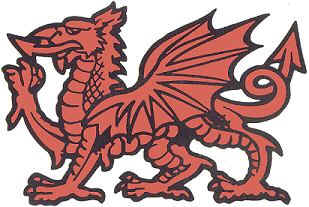
| Dragon
Some sat that this symbol was brought to these isles by the Romans. The ancient welsh poets Aneirin and Taliesin used the Welsh word for dragon �draig� to refer to Welsh warriors.
The oldest recorded use of the dragon to symbolise Wales is from the Historia Brittonum, written around 820, but it is popularly supposed to have been the battle standard of King Arthur and other ancient Celtic leaders.
Adopted as an emblem by Edmund and Jasper Tudor it eventually became the symbol of Wales. The Welsh flag featuring the dragon was granted official status in 1959.
Y Ddraig Goch (Welsh for the red dragon) appears on the national Flag of Wales, and is the most famous dragon in Britain. There are many legends about y Ddraig Goch.
In the Mabinogion story Lludd and Llevelys, the red dragon fights with an invading white dragon. His pained shrieks cause women to miscarry and animals and plants to become barren. Lludd, king of Britain, goes to his wise brother Llevelys in France. Llevelys tells him to dig a pit in the centre of Britain, fill it with mead, and cover it with cloth. Lludd does this.The dragons drink the mead and fall asleep, and Lludd imprisons them, still wrapped in their cloth, in Dinas Emrys in Snowdonia (Welsh: Eryri).
The tale is taken up by Nennius in the Historia Britonum. The dragons remain at Dinas Emrys for centuries until King Vortigern tries to build a castle there. Every night the castle walls and foundations are demolished by unseen forces. Vortigern consults his advisers, who tell him to find a boy with no natural father, and sacrifice him. Vortigern finds such a boy (who is, in some tellings, to later become Merlin) who is supposed to be the son of a demon. On hearing that he is to be put to death to solve the demolishing of the walls, the boy dismisses the knowledge of the advisors. The boy tells the king of the two dragons. Vortigern excavates the hill, freeing the dragons. They continue their fight and the red dragon finally defeats the white dragon. The boy tells Vortigern that the white dragon symbolises the Saxons and that the red dragon symbolises the people of Vortigern. If Vortigern is accepted to have lived in the fifth century, then these people are the British whom the Saxons pushed back to the edges of Britain and who are today called the Welsh. |
